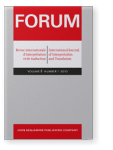Vol. 8:1 (2010) ► pp.103–127
Current State and Challenges of Interpreter Education in Malaysia
L’enseignement et la formation jouent un rôle très important dans la professionnalisation d’une occupation (Cordero, 1994; Grossman, 2002; Pöchhacker, 2004; Schmitz, 1988; Schubert, 1988; Tseng, 1992). Alors que ces deux processus sont étroitement liés, ils diffèrent sous l’angle des procédés, de la précision, du contenu et de l’échelle de temps (Buckley & Caple, 2004; Kenny & Reid, 1986). Il faut tenir compte de ces différences dans la planification et l’approche pédagogique des programmes d’enseignement théorique et de formation pratique des interprètes, notamment pour satisfaire les besoins du marché d’interprétation et pour assurer que ses exigences soient satisfaites au moyen d’un enseignement et d’une formation pratique efficaces (Pöchhacker, 2004; Tseng, 1992) L’Universiti Sains Malaysia est la seule institution universitaire en Malaisie qui offre un diplôme (B.A.) en traduction et interprétation. Cet exposé analyse la structure du programme, le nombre de candidats, l’intérêt que portent les étudiants à la profession d’interprète, l’infrastructure et les ressources d’enseignement et d’apprentissage, les problèmes et les contraintes liés à l’enseignement de l’interprétation en el diplôme, enfin, suggère des pistes pour améliorer l’enseignement de l’interprétation en Malaisie.
